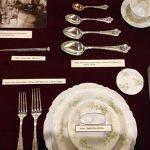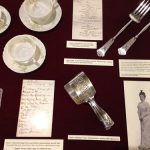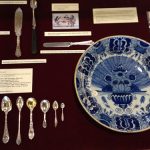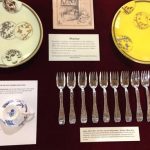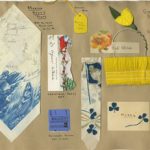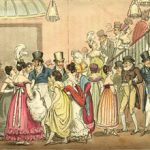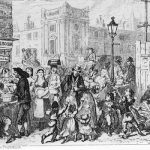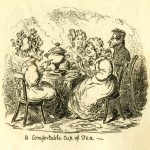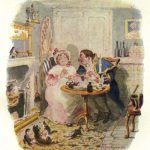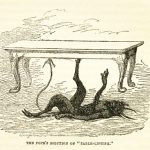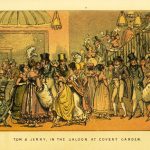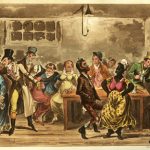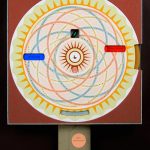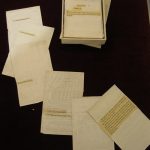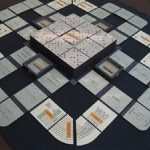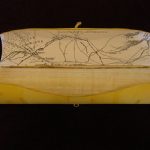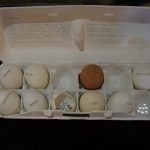Past Harris Lobby Exhibits
Fall 2016
Norman M. Fox (1919-2016): Book Collector, Innovator, and Friend of Skidmore College and Saratoga Springs

Born in Brooklyn in 1919, Norman was the son of Russian immigrants. He moved to Saratoga Springs in 1947 with his wife Eva. Among Norman and Eva’s first Saratoga friends were Charles and Hannah Adler. The Foxes and the Adlers shared a love of rare books. When Charles Adler went abroad to become a conductor of the Vienna Philharmonic, the Adlers loaned their renowned illustrated book collection to Skidmore College. Norman was first the steward of this collection and then became its owner.
Norman took delight in the ways the Fox Collection became an invaluable resource for Skidmore faculty and students. Under the guidance of Catherine Golden, Professor of English, and Wendy Anthony, Special Collections Curator, students have created countless library exhibitions and catalogues based on this rich collection.
In 1990, when Hannah Adler passed away, Norman used a bequest from her estate to initiate a yearly lecture (then called the Adler Lecture) to discuss 19th-century literature and art. The lecture series, renamed the Fox-Adler lecture series, has featured prominent scholars, journalists, book artists, and bibliophiles. In 2005 the Fox family gave what is now known as the Fox Collection to the College along with a generous gift to endow the lecture series in perpetuity. Norman suggested many topics for the Fox-Adler Lecture, such as talks on George Cruikshank, William Blake, Arthur Szyk, book collecting, and Leonard Baskin, the subject of this year’s lecture. Mark Dimunation, Chief of the Rare Books and Special Collections Division of the Library of Congress, will deliver the 28th annual Fox-Adler lecture on Thursday, September 15th at 5:15 PM in Gannett Auditorium: “Strange and Marvelous Books: Leonard Baskin and the Gehenna Press.” We will honor Norman’s legacy at the opening of this year’s Fox-Adler lecture.
Exhibit curated by Wendy Anthony, Special Collections Curator and Catherine Golden, Professor of English.
The exhibit will be on display in the Harris Lobby in the Scribner Library through August. In conjunction with this topic, please also see the Tang Museum’s Leonard Baskin exhibit page. This exhibition of prints by Leonard Baskin is organized in honor of Norman A. Fox and the annual Fox-Adler lecture. The Museum will hold the Leonard Baskin Exhibit in the Payne Presentation Room from August 13 to October 2.
Spring 2016
Remembering David Porter: Skidmore’s Fifth President

This exhibit looks back on David Porter’s years at Skidmore and the impact he had on the College and its community. It features photographs, articles from Skidmore News, books, and other materials from the Department of Special Collections, as well as tributes from family, friends, and colleagues.
Exhibit curated by Wendy Anthony, Special Collections Curator and Jane Kjaer, Public Access Assistant.
The exhibit will be on display in the Harris Lobby in the Scribner Library through June.
Fall 2015
Graphic Matter: 20th Century Illustrated Books from Special Collections

The Lucy Scribner Library’s Department of Special Collections contains many rare and unique books with graphic illustrations. This exhibit includes a selection of 20th century books that feature narrative images. Many of these books can be seen as precursors to the modern graphic novel.
Exhibit curated by Yvette Cortes, Fine Arts Librarian
Summer-Fall 2015
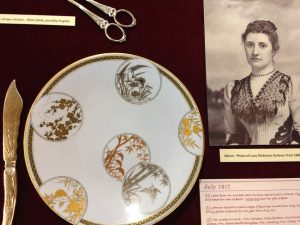
In the spring of 2014, the library was contacted about a cartload worth of boxes containing silverware, porcelain and other household items believed to have belonged to the founder of Skidmore College, Lucy Skidmore Scribner.
The items were transferred to the Special Collections department and put under the care of staff member Jane Kjaer, who carefully researched and cataloged each item. This exhibit is a result of Kjaer’s research and curating work and showcases a sample of Mrs. Scribner’s items with a brief discussion of Victorian dining customs.
Exhibit curated by Jane Kjaer, Public Access Assistant
The exhibit will be on display in the Harris Lobby in the Scribner Library through the end of August.
Spring 2015
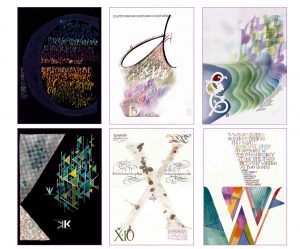
The Lucy Scribner Library’s Department of Special Collections contains many rare and unique books with alphabetical elements. This exhibit includes a mix of artists’ books and illustrated books that feature creative uses of the letters of the alphabet.
Exhibit curated by Yvette Cortes, Fine Arts Librarian
The exhibit will be on display in the Harris Lobby in the Scribner Library through April 15.
Please check out our Flickr page for images from the exhibition.
Fall 2014
Original Objects: Artists’ Books from Special Collections
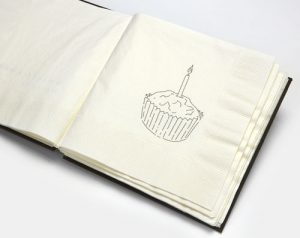
What distinguishes an artist’s book from an art book? Unlike an art book, which is a representation of artists’ works and ideas, an artists’ book is itself an original work of art, visually and conceptually whole.
The Artists’ Books collection is the only one among the Scribner Library’s rare book collections to receive new purchases every year thanks to a generous donor’s endowment. This exhibition features a selection of books from the collection.
Exhibit curated by Yvette Cortes, Fine Arts Librarian
The exhibit will be on display in the Harris Lobby in the Scribner Library through December 2014.
Many of the books in the exhibit can be viewed in the Lucy Scribner Library’s Digital Collections.
For resources on artists’ books, please see our Artists’ Books Subject Guide.
Spring 2014
Collecting Special Collections
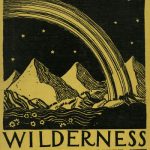
Collecting Special Collections, the current exhibit in the Harris Lobby, showcases unique items from Skidmore’s Department of Special Collections, home to the College’s rare books and archives. Our rare books collection is made up of the General Collection and numerous smaller named collections, such as the John J. Cunningham Science Fiction Collection.
Materials on display represent the delightfully eclectic nature of our General Collection, where an old favorite children’s book shares space with an illuminated Book of Hours from the 1440s and Edward Curtis’s The North American Indian. Among the individual collections featured, the Artists’ Books and the Fox Collection are also highlighted.
An artist’s book is itself an original work of art, as visually and conceptually whole as a painting or sculpture. This collection is the only one among our rare book collections to receive new purchases every year thanks to a generous donor’s endowment. It has been carefully and wisely developed over the years by College Librarian Ruth Copans. Additional selections from our Artists’ Books are also available through our Digital Collections.
The Fox Collection contains over 400 books predominantly from the Victorian era. It was collected with a strong focus on the illustrated books from that time period. The collection showcases in particular the works of George Cruikshank but also features authors and illustrators such as William Blake, Robert Browning, Lewis Carroll, Charles Dickens, and the Grimm Brothers. The Fox collection is a perennial favorite of Skidmore students and faculty alike, and is the most heavily utilized rare book collection in Special Collections.
The exhibit will be on display through February 13, 2014.
Please check out our Flickr page for images from the exhibition.
Memories of 1920s Skidmore: Featuring Agnes Ritchie Class of 1929’s Scrapbook
Memories of 1920s Skidmore, the current exhibit in the Harris Lobby, features the scrapbook of Agnes Ritchie, Skidmore class of 1929. This unbound scrapbook was donated by her daughter Connie Talcott Smith, who is also a Skidmore graduate, from the class of 1963. The Department of Special Collections owns a number of alumni scrapbooks, and these first-hand depictions of life at Skidmore in years gone by are a perennial favorite of students and staff. Due to their format they are difficult to exhibit well, so when this scrapbook arrived without a binding we were delighted to be able to share it in the exhibit cases.
Agnes Ritchie’s arrival at Skidmore coincided with Skidmore’s first decade as a college, a time that is understandably unique to the school’s history. It was when Skidmore developed the foundations of its character as an institution, tried to find its bearings as a newly minted college, and struggled to survive financially. Some of the supporting materials in this exhibit will touch upon those issues, but of course they would hardly have been expected to be at the forefront of Agnes Ritchie’s mind as she arrived at Skidmore a young woman eager to explore and enjoy all that life has to offer at that stage of our lives. Please enjoy your time visiting with Agnes and Skidmore of the 1920s.
The exhibit will be on display through March 31, 2014. You may also peruse a digital “flip book” of Agnes’ scrapbook online.
Please check out our Flickr page for images from the exhibition.
Summer 2013
Llym Awel: Sharp as the Wind
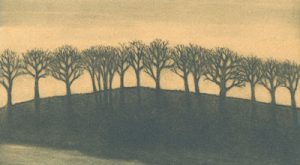
Llym Awel: Sharp as the Wind, an artist’s book by Shirley Jones, consists of translations of selected verses from seventh to thirteenth century Welsh poetry, set and printed by her alongside the early Welsh, in 18pt Perpetua italic. The columns of verse printed in two colors, on Barcham Green handmade paper, face her six mezzotints and a relief etching of Welsh landscapes. One double-page mezzotint is overprinted with the poetry. This copy is from a limited edition of 40, and is currently on exhibit in the Harris Lobby through mid-August. The Scribner Library currently owns 13 additional works by Jones, which can be viewed in Special Collections.
Shirley Jones of Red Hen Press is a writer, artist and printer. After teaching English in London for seven years, she took courses in lithography, etching and sculpture before attending Croydon College of Art and Design, where she published her first two artist’s books.
She set up her own studio and continued to publish her etchings and mezzotints to complement her poems, prose pieces and translations from Old English and Old Welsh. In 1983 she named her press Red Hen Press. She set and printed her letterpress in editions limited to 40.
Each of her books is a total concept, with the choice of paper and typeface, the unity of text and images, and harmony of the binding as carefully considered as the visual and literary creativity involved.
She officially retired from book making in 2012 and lives in Wales.
Spring 2013
Humans and Animals on Display
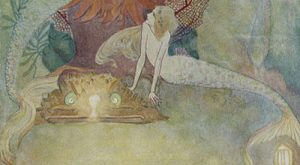
The Victorian era witnessed the rise of animal protection, zoos, veterinary medicine, cattle and sheep breeding, vegetarianism, antivivisection, pet keeping, and dog and cat shows. But it also beheld big game hunting, blood sports, animal abuse, a burgeoning fashion industry that threatened animal populations, and widespread fears of our animal ancestry, sparked by Darwinian evolution. This exhibition explores this Victorian menagerie that puts humans and animals on display.
Students in Dr. Catherine J. Golden’s EN 228H course entitled “The Victorian Illustrated Book” created five cases (four in the Harris Lobby and one in the Pohndorff Room) that exhibit these human-animal interactions in culture and literature with particular attention to animal protection and endangerment, domination over the animal kingdom, humanized animals, and fantastical creatures (flying horses, mermaids, and magical hares).
In each case, we witness animals as an indelible part of Victorian life and culture, but also as a crucial part of nineteenth-century thought. Animals serve as metaphors for the imagination, psychological needs, sociopolitical aspirations, and imperialism.
The exhibit will be on display until June 14, 2013.
Please check out our Flickr page for images from the exhibition.
Fall 2012
Inappropriate: The Art of Children’s Books
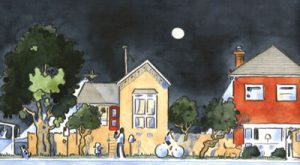
This exhibit introduces Skidmore’s 24th Fox-Adler Lecturer, author and illustrator, Elisha Cooper. As this exhibit illuminates, the topics of Cooper’s books are far ranging. He writes about beavers, roosters, dogs, ballparks, beaches, farms, cows, becoming a father, country fairs, riding the subway, ice cream, cats, and dance.
Cooper’s life experience is the source of his creative accomplishments for children as well as adults. Cooper’s first book, A Year in New York (1995), is what he calls an “illustrated journal.” His inspiration came from his job as a messenger for the New Yorker – he based the book on sketches he made on the subway en route to his deliveries. His second book, Off the Road: An American Sketchbook (1996), grew out of his cross-country adventure after he quit his job at the New Yorker. The New York Times calls Crawling: A Father’s First Year (2006), “A bravely honest memoir of parenthood.” It is a memoir about his experiences as a new father.
Cooper has written and illustrated well over a dozen children’s books. His topics resonate with inquisitive children eager for a believable narrative. Dance!, drawing upon his own experience taking ballet at Yale to improve his football playing, was a New York Times Ten Best Illustrated winner in 2001. Beach – which presents a summer day at a Midwestern beach he visited near Chicago – was a Society of Illustrators Gold Medal best illustrated book of the year in 2006. A visit to the Chicago Zoo with his daughters led to the creation of Beaver is Lost (2010). Cooper’s latest book, Homer (2012), features a big, loyal yellow lab named Homer, named after his own childhood dog.
text by Catherine J. Golden, Professor of English
Exhibited curated by Wendy Anthony, Special Collections Curator
The exhibit will be on display in the Harris Lobby through the Fall 2012 semester
Skidmore in Wintertime: A Look back
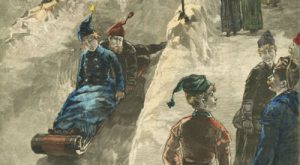
Saratoga has always played a significant role in Skidmore student life. This was particularly true before the late 1960’s when the campus was located entirely downtown. This exhibition consists mainly of photographs of downtown Saratoga Springs in winter, from the late 1800’s through the 1940’s.
The photographs are part of the Skidmore College Archives, which maintains documents, publications, photographs, and other items of significance to Skidmore College’s history.
Exhibited curated by Wendy Anthony, Special Collections Curator
The exhibit will be on display in the Harris Lobby through December 2012.
Spring 2012
Past and Present: An Illustrated Look at Regency and Victorian Times Versus Today
“Past and Present: An Illustrated Look at Regency and Victorian Times Versus Today” examines aspects of our modern age in relation to Regency and Victorian tomes, focusing on “past” and “present” in beverage consumption, fashion, popular icons, childhood, and entertainment.
Together the five cases provide an illustrated look of how our present world resembles and departs from the past and hopfullt rekindles interest in the long 19th century, the dawning of our modern era.
Dr. Catherine Golden, Professor of English
EN228H, “The Victorian Illustrated Book,” Spring 2012
The exhibit will be on display in the Harris Lobby until May 5, 2012.
Modern Art & Design, 1925-1965: Selections from Special Collections
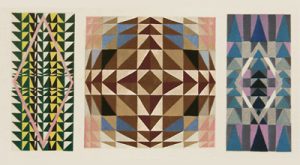
The Scribner Library’s Department of Special Collections contains many rare and unique books related to modern art and design. Many of these books were printed in very limited editions and contain original prints.
The exhibition features a mix of art books and illustrated books such as Sonia Delaunay’s Ses Peintures, Ses Objets, Ses Tissus Simultanés, Ses Modes, Karl Blossfeldt’s Urformen der Kunst, Richard Wilbur’s A Bestiary with illustrations by Alexander Calder, Frank Lloyd Wright’s Drawings for a Living Architecture, and Man Ray’s Alphabet for Adults. Also included are several issues of Verve magazine, a quarterly review of arts and letters published from 1937 – 1960.
Exhibited curated by Yvette Cortes, Fine Arts Librarian
The exhibit will be on display in the Harris Lobby in the Scribner Library through March 26th.
Please check out our Flickr page for images from the exhibition
Fall 2011
New Artists’ Books from the Department of Special Collections
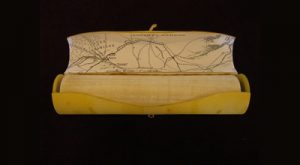
What is an artist’s book?
Artists’ books are not just about art, but are also considered actual works of art in and of themselves. Usually produced in limited editions, these “books” can be created out of anything, thus challenging and expanding our notion of what “books” are. The Scribner Library owns many artists’ books which are part of the Department of Special Collections. And the Library is continuously adding new ones! This exhibit contains some of their most recent acquisitions.
Curated by Marina Filisky ’12 for the Honors Forum Citizenship Project
The exhibit will be on display in the Harris Lobby in the Scribner Library through December 2011.
To learn more about some of the artists’ books in Special Collections, see Artists’ Books from Special Collections.
For resources on artist’s books, see the Artists’ Books Research Guide.
Curious Covers: Edward Gorey’s Art for Other Authors
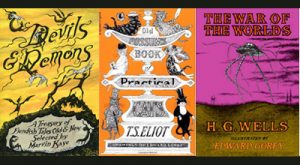
Edward Gorey (1925-2000), the American author and illustrator of more than 100 of his own books, also illustrated the covers of over 80 books by other authors such as Edward Lear, H.G. Wells, T.S. Eliot, Fyodor Dostoevsky, John Ciardi, Peter Neumeyer, and many others.
Gorey designed book covers for a wide variety of literature such as the classics, poetry, horror anthologies, and children’s picture books and novels. Rather than collaborate with other authors on his covers, he drew what he felt best evoked the essence of the book. As he explained, “They usually produce the text, and I do the drawings without consulting them.”
His book covers all have his distinctive style, with his vaguely Victorian/Edwardian linear pen and ink drawings. The covers have strong unique compositions, and display his intricate cross-hatching and signature hand-lettering. Even the spines have his hand-drawn typography, making them stand out on a bookshelf. The best of these covers feature the same macabre yet whimsical sensibility found in Gorey’s own works. He once said, “My mission in life is to make everyone as uneasy as possible.”
Gorey’s art was influenced by the Surrealists, especially Max Ernst, and by artists such as Balthus, Pierre Bonnard, Paul Klee, Francis Bacon, and Johannes Vermeer. He also had a fondness for 19th-century book illustration and silent films. He taught himself to draw, only completing a few courses at the Art Institute of Chicago.
Gorey’s works have an avid following throughout the world. A few years before his death, he reflected upon his career. “My name turns up in a review of a book or something where they say it’s very ‘Edward Goreyish’ or something like that. That happens often enough, so I feel I’ve made a tiny mark somewhere.”
Exhibited curated by Yvette Cortes, Fine Arts Librarian
The exhibit will be on display in the Harris Lobby in the Scribner Library through November.
Please check out our Flickr page for images from the exhibition.
Arthur Szyk: Book Illustrator Extraordinaire
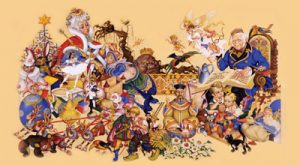
During his lifetime (1894-1951), Arthur Szyk – pronounced “Schick” – earned fame in Poland, France, Canada, the United States, and Israel for his exquisite book illustrations, religious art, miniatures, political caricatures, and postage stamp designs. An activist-artist, Szyk conceived of art as a means to make a case for social justice. Szyk, who was trained in art in France but identified himself as a Pole and a Jew, documented the atrocities of Hitler, Hirohito, and Mussolini and caricaturized these fascist leaders. In art, he worked for a Jewish homeland but also championed displaced and oppressed Poles, Brits, Native Americans, African Americans, and Indonesian Muslims (facing prejudice from the Dutch in the 1940s). Szyk’s magnum opus, the Szyk Haggadah, debuted in London in 1939. Following its publication, Szyk immigrated to the United States in 1940 in the wake of the Holocaust.
Hailed the greatest miniaturist since the 16th century, Szyk became virtually forgotten following his death in 1951. Until now, you may never even have heard of him. The extraordinary output of Arthur Szyk will be the subject of the 23rd annual Fox-Adler Lecture to be delivered by Irvin Ungar, foremost Szyk scholar and art dealer and major proponent of a Szyk renaissance. In a recent interview for AIGA (the professional association for design), Ungar notes that Szyk’s “unique style . . . combines use of color with a miniaturist’s attention to detail[;] Szyk departs from all schools of art and yet embraces many of them.” To Ungar, “Szyk’s prodigious output—illustrated books, and magazine and newspaper political art, as well as nationalistic portraits and illuminated religious works—would together qualify him as a school of art in his own right.”
These four cases illuminate Szyk’s multifaceted oeuvre—a “school of art in [its] own right.” Case 1 entitled “Portfolio Extraordinaire” showcases Szyk’s artistic range and the extraordinary range of texts he illustrated: fairy tales to the Bible, portraits of George Washington to postage stamps. Case 2 entitled “Illustrator of Tales for Adults and Children” showcases Szyk’s renowned illustrations for Hans Christian Andersen’s fairy tales alongside The Canterbury Tales. Case 3, “Preserving the Faith, Defending the Faith,” features Szyk’s role as defender of justice. Caricatures of Hitler in The New Order (1841) show Szyk to be a “hater of hatred” while his illustrations for The Book of Job and The Haggadah demonstrate pride in his Jewish heritage during a time when it was dangerous to be Jewish. Cases 3 and 4 document Szyk’s Zionist efforts. Case 4, “Szyk and Philately,” features postage labels for the Zionist movement as well as stamps for Israel, the Jewish state Szyk was so proud of, and Liberia, the African nation America helped to found.
This exhibit was mounted by Catherine J. Golden, Professor of English; Wendy Anthony, Special Collections Curator; and Lollie Abramson, Coordinator of Jewish Life, and will be on display in the Harris Lobby in the Scribner Library through the end of September 2011.
Please check out our Flickr page for images from the exhibition.
Spring 2011
Victorians Speaking Without Words
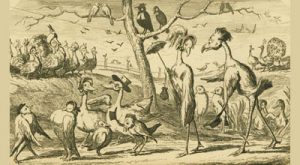
“Victorians Speaking Without Words” explores how the nineteenth-century artist and illustrator worked with a recognizable vocabulary of expression, gesture, and detail to present a moral – make a statement about gender, social class, or politics of the day, or speak to the condition of the age.
Students in Dr. Catherine Golden’s EN 228H course entitled “The Victorian Illustrated Book” created six cases (4 in the Harris Lobby and 2 in the Pohndorff Room) that showcase the language of the fan and the language of flowers, both popular in the Victorian era, as well as exaggerated caricature-style and animal imagery in order to teach viewers about love, marriage, morality, heartbreak, and hope. Fans, flowers, figurines, and telling details on a mantel speak volumes once we glean the nonverbal languages of Victorian times. The exhibit will be on display until May 5, 2011.
Please check out our Flickr page for images from the exhibition.
A 45th Anniversary Exhibition: Salmagundi Magazine
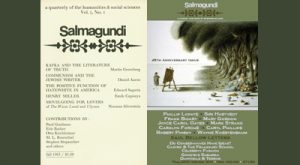
Salmagundi is a quarterly of the Humanities and Social Sciences which is addressed to the “general” reader rather than to the academic specialist. Founded in 1965 and published since 1969 at Skidmore College, the magazine routinely publishes essays, reviews, interviews, fiction, poetry, regular columns, polemics, debates and symposia.
Among the writers long associated with Salmagundi are Nadine Gordimer, J.M Coetzee, George Steiner, Christopher Hitchens, Seamus Heaney, Mary Gordon, Susan Sontag, Benjamin Barber, Joyce Carol Oates, Richard Howard, and Martin Jay.
To mark the 45th anniversary of Salmagundi, the editors have put together an exhibition of archival materials including:
Personal letters from Nobel-prize winners like Seamus Heaney and Mario Vargas Llosa, and others from leading American writers like Louise Gluck, Don DeLillo, Allan Gurganus and Mary Gordon
Photographs of Salmagundi events and conferences on the Skidmore campus
Many other items selected from many thousands of documents from the magazine’s archives.
The assembled materials provide a glimpse into the record of a magazine that has played a significant role in the life of the college for more than forty years.
For more information about Salmagundi and its history, see the Salmagundi website.
Salmagundi also maintains a blog, Salmagundi: Art and Culture Quarterly, which features videos of readings by authors such as Joyce Carol Oates, Rick Moody, Russell Banks, and many more.
Current issues of Salmagundi are located on the first floor of the Scribner Library. Back issues of Salmagundi (going all the way back to the very first issue) are located in Hoge.
The exhibition will be on display in the cases by the library entrance (1st floor) through April 2011.
Altered Books in the Library
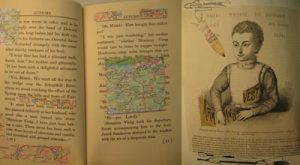
Remember when you were a kid, and you used scribble crayon all over your favorite books? Well now’s your time to go with those instincts! The books you can alter are on reserve behind the circulation desk; just ask at the desk if you can borrow an altered book. There are 5 in total and you can borrow one at a time for 3 days. Alter the book and then bring it back for the next person to alter.
These books are to be changed in any way you see fit. Collage, paint, draw, print, dye, or write on them. Use the book as a medium. This project is designed to reflect Skidmore’s culture here and now, so add your own perspective!
The 5 books on reserve are:
- Gibbs, George Fort. Autumn: the Eighteen-thirties. New York: D. Appleton and Co., 1931.
- Andrews, Mary Raymond Shipman. Vive l’Empereur. New York: C. Scribner’s Sons, 1902.
- Wesselhoeft, Lily F. Ready the Reliable. Boston: Little, Brown, and Co., 1906.
- Favre, Abbé de. Beauty’s Day. London: Vizetelly & Co., 1890.
- Rawson, Hugh. A Dictionary of Euphemisms & Other Doubletalk. New York: Crown Publishers, Inc., 1981.
Altered Books in the Library is a continuation of the work Skidmore student Caitlin Allen ’12 did over the summer as part of a collaborative research grant. Professor Michelle Rhee and Allen curated a show titled Eye Rhymes in the Tang Museum for Rhee’s freshman seminar Ways of Seeing.
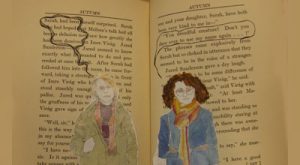
For examples of other altered books see:
Curator’s Corner: The Sticky Topic Of Altered Books
Fall 2010
Reevaluating the Roles of Women in Medieval Judaism, Christianity and Islam
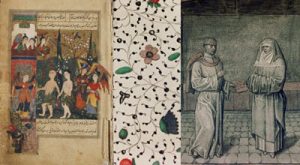
This exhibit is the culmination of a summer collaborative research project between Skidmore student Kali Block-Steele ’13 and Professor Kate Greenspan of the English Department.
The research was funded by a Scribner-Mellon Grant and was initially inspired by Block-Steele’s interest in Islam and the time she spent with Muslim Iraqi students in the summer of 2008. This research examines the role of women in the three major monotheistic Abrahamic religions: Judaism, Christianity, and Islam.
Block-Steele worked to re-examine the stereotypes many people have about women in these three religions by researching their roles in them during the Middle Ages.In addition to this exhibit, Block-Steele and Greenspan are producing a catalog of selected images accompanied by Block-Steele’s essay on her research. This catalog will be available for viewing in Special Collections later this semester.
The exhibit will be on display in the cases by the library entrance (1st floor) through November 2010.
The Annotated Image
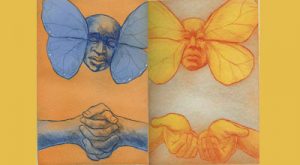
This exhibition features the provocative work of Michael Kuch, a printmaker and book artist who pushes the realm of the possible and, in doing so, creates artists’ books that give us great insight into timely world issues. Joining reality and fantasy, Kuch—a protégé of pioneering book artist Leonard Baskin—merges human figures with natural forms. Characters from mythology and the Bible comment on our times.
In Falling to Earth (2002), featured in the first case, Kuch offers a poignant response to the tragic collapse of the World Trade Center Towers. He incorporates angels, Jacob’s Ladder, and the mythical Icarus, who flies to close to the sun with his wax wings; “Greek mythology warns us about trying to reach too high. Tragedy is a consequence of that,” notes Kuch in a February 2002 article in Hampshire Life. Falling is a metaphor for the physical and spiritual costs of violence, but Kuch’s work is also about healing.
In the second case, Kuch’s earlier 1999 book entitled Apocalypse Clocks offers a meditation on timelessness and the ephemeral associated with the new millennium. The third case includes work from Michael Kuch’s collaboration with poet Anthony Hecht in Séance for a Minyan (2001). In this work, Kuch’s intaglio prints paired with evocative poems by Hecht show Biblical characters forming a figurative minyan, the quorum needed to commence prayer under Jewish law.
Kuch’s most recent book and second collaboration with Oxindale Press is the focus of the final case. Waterlines: Après Moi Le Deluge & Orpheus on Sappho’s Shore (2009) features illustrated musical works in which human agony finds solace in the redemption of music. In “Après Moi,” a chorus questions why Noah has forgotten the victims of Hurricane Katrina.
Michael Kuch will deliver the 22nd Fox-Adler Lecture entitled “The Annotated Image: When Picture Precedes Text—the Books of Michael Kuch” on Thursday, September 23rd at 5:15 PM in Gannett Auditorium. The lecture is free and open to the public. A reception will follow in the Schick Art Gallery, which features an exhibit of his work.
Dr. Catherine J. Golden
Professor of English
Exhibited mounted by Catherine J. Golden, Professor of English and Wendy Anthony, Special Collections Curator
The exhibit will be on display in the cases by the library entrance (1st floor) through October 10, 2010.
Spring 2010
Saratoga Springs After the Civil War

This exhibit was assembled by Anna Hymowitz, Class of 2010 (Art History and Government double major) as part of an independent study supervised by Mimi Hellman, Professor of Art History, on Saratoga Springs after the Civil War.
Despite the continuous fighting in the South, Saratoga was becoming increasingly successful as a resort town. The images in the exhibition, dating from 1862 to 1885, highlight how Saratoga attracted visitors through leisure activities, technological innovation, and commemoration of a national hero.
The images are from the publications Harper’s Weekly, Harper’s Monthly Magazine, Frank Leslie’s Illustrated Newspaper and a tourist booklet that was given out at Mount McGregor in the 1880’s. The original newspaper prints are from the Yates Collection of Saratogiana in Special Collections, and the scanned newspaper images are from the Saratoga Room of the Saratoga Springs Public Library.
The exhibit will be on display in the cases by the library entrance (1st floor) through July 2010.
Barry Moser’s Alice in Wonderland
In celebration of the release of Tim Burton’s latest film, Alice in Wonderland, these illustrations from Barry Moser’s two artist’s books based on Alice – Lewis Carroll’s Alice’s Adventures in Wonderland and Lewis Carroll’s Through the Looking Glass and What Alice Found There – have been selected for exhibition. Additional prints from the works are available for viewing in the Library’s Special Collections by appointment.
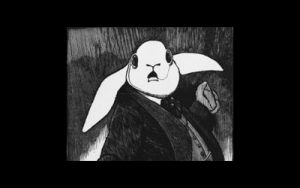
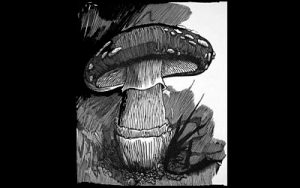
The exhibit will be on display in the cases by the library entrance (1st floor) through mid-April.
For more information on Barry Moser:
- Barry Moser and the Pennyroyal Press
- Barry Moser Biography and Works at R. Michelson Galleries
- Barry Moser at the Museum of Ancient and Modern Art (MAMA)
Springtime at Skidmore: A Look Back
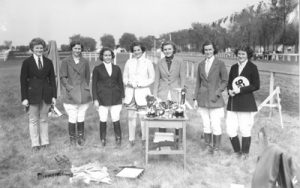
Springtime at Skidmore takes a look back at a sampling of spring activities and traditions from Skidmore’s past. Focused primarily from 1916 to the 1960’s, the exhibit is chiefly comprised of yearbooks, programs, and photographs from Scribner Library’s Special Collections Archives. The exhibit focuses on traditional spring events from the past such as May Day, The Annual Horse Show, Junior Prom and Spring Fling Weekend. Some of these traditions fell out of fashion long ago, while others still continue today. Taking a look back at these traditions is a fun way to re-examine the spring semester and how Skidmore students from the past celebrated this time of year!
This exhibit was assembled by Lauren Draus, Library Assistant in Bibliographic Services.
The exhibit will be on display in the cases by the library entrance (1st floor) through mid-April 2010.
